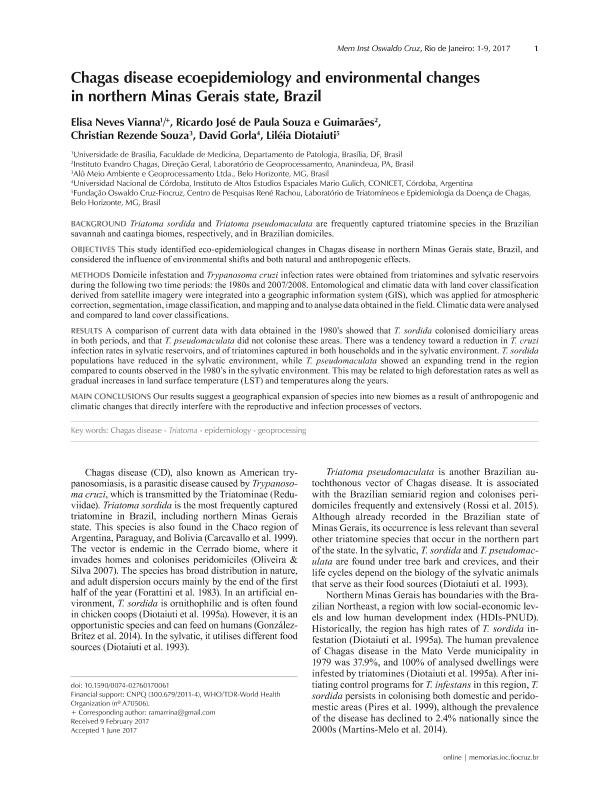Mostrar el registro sencillo del ítem
dc.contributor.author
Neves Vianna, Elisa

dc.contributor.author
Souza e Guimarães, Ricardo José de Paula
dc.contributor.author
Souza, Christian Rezende
dc.contributor.author
Gorla, David Eladio

dc.contributor.author
Diotaiuti, Liléia

dc.date.available
2018-04-18T21:53:19Z
dc.date.issued
2017-11
dc.identifier.citation
Neves Vianna, Elisa; Souza e Guimarães, Ricardo José de Paula; Souza, Christian Rezende; Gorla, David Eladio; Diotaiuti, Liléia; Chagas disease ecoepidemiology and environmental changes in northern Minas Gerais state, Brazil; Fundação Oswaldo Cruz; Memórias do Instituto Oswaldo Cruz; 112; 11; 11-2017; 760-768
dc.identifier.issn
0074-0276
dc.identifier.uri
http://hdl.handle.net/11336/42578
dc.description.abstract
BACKGROUND Triatoma sordida and Triatoma pseudomaculata are frequently captured triatomine species in the Brazilian savannah and caatinga biomes, respectively, and in Brazilian domiciles. OBJECTIVES This study identified eco-epidemiological changes in Chagas disease in northern Minas Gerais state, Brazil, and considered the influence of environmental shifts and both natural and anthropogenic effects. METHODS Domicile infestation and Trypanosoma cruzi infection rates were obtained from triatomines and sylvatic reservoirs during the following two time periods: the 1980s and 2007/2008. Entomological and climatic data with land cover classification derived from satellite imagery were integrated into a geographic information system (GIS), which was applied for atmospheric correction, segmentation, image classification, and mapping and to analyse data obtained in the field. Climatic data were analysed and compared to land cover classifications. RESULTS A comparison of current data with data obtained in the 1980’s showed that T. sordida colonised domiciliary areas in both periods, and that T. pseudomaculata did not colonise these areas. There was a tendency toward a reduction in T. cruzi infection rates in sylvatic reservoirs, and of triatomines captured in both households and in the sylvatic environment. T. sordida populations have reduced in the sylvatic environment, while T. pseudomaculata showed an expanding trend in the region compared to counts observed in the 1980’s in the sylvatic environment. This may be related to high deforestation rates as well as gradual increases in land surface temperature (LST) and temperatures along the years. MAIN CONCLUSIONS Our results suggest a geographical expansion of species into new biomes as a result of anthropogenic and climatic changes that directly interfere with the reproductive and infection processes of vectors.
dc.format
application/pdf
dc.language.iso
eng
dc.publisher
Fundação Oswaldo Cruz

dc.rights
info:eu-repo/semantics/openAccess
dc.rights.uri
https://creativecommons.org/licenses/by-nc-sa/2.5/ar/
dc.subject
CHAGAS DISEASE
dc.subject
EPIDEMIOLOGY
dc.subject
GEOPROCESSING
dc.subject
TRIATOMA
dc.subject.classification
Otras Ciencias Biológicas

dc.subject.classification
Ciencias Biológicas

dc.subject.classification
CIENCIAS NATURALES Y EXACTAS

dc.title
Chagas disease ecoepidemiology and environmental changes in northern Minas Gerais state, Brazil
dc.type
info:eu-repo/semantics/article
dc.type
info:ar-repo/semantics/artículo
dc.type
info:eu-repo/semantics/publishedVersion
dc.date.updated
2018-04-16T14:40:56Z
dc.identifier.eissn
1678-8060
dc.journal.volume
112
dc.journal.number
11
dc.journal.pagination
760-768
dc.journal.pais
Brasil

dc.journal.ciudad
Rio de Janeiro
dc.description.fil
Fil: Neves Vianna, Elisa. Universidade do Brasília; Brasil
dc.description.fil
Fil: Souza e Guimarães, Ricardo José de Paula. Instituto Evandro Chagas; Brasil
dc.description.fil
Fil: Souza, Christian Rezende. Alô Meio Ambiente e Geoprocessamento; Brasil
dc.description.fil
Fil: Gorla, David Eladio. Comision Nacional de Actividades Espaciales. Instituto de Altos Estudios Espaciales ; Argentina. Consejo Nacional de Investigaciones Científicas y Técnicas; Argentina
dc.description.fil
Fil: Diotaiuti, Liléia. Fundación Oswaldo Cruz; Brasil
dc.journal.title
Memórias do Instituto Oswaldo Cruz

dc.relation.alternativeid
info:eu-repo/semantics/altIdentifier/doi/http://dx.doi.org/10.1590/0074-02760170061
dc.relation.alternativeid
info:eu-repo/semantics/altIdentifier/url/http://ref.scielo.org/54cnfd
dc.relation.alternativeid
info:eu-repo/semantics/altIdentifier/url/https://www.ncbi.nlm.nih.gov/pmc/articles/PMC5661899/
Archivos asociados
